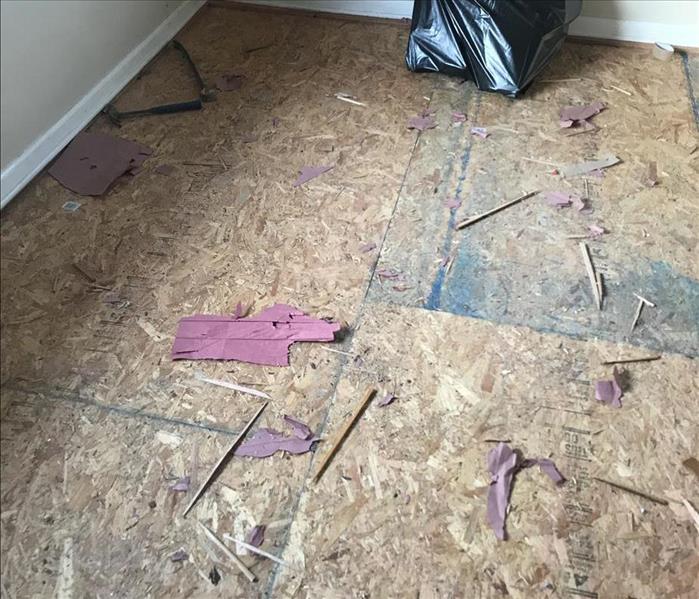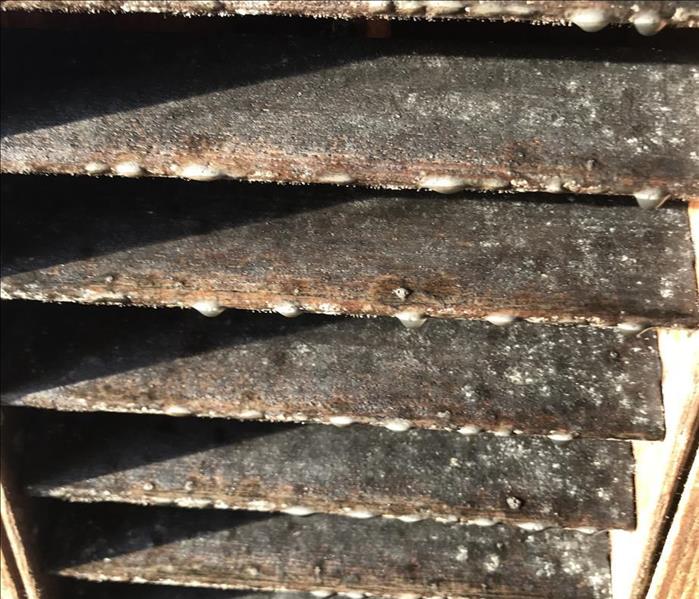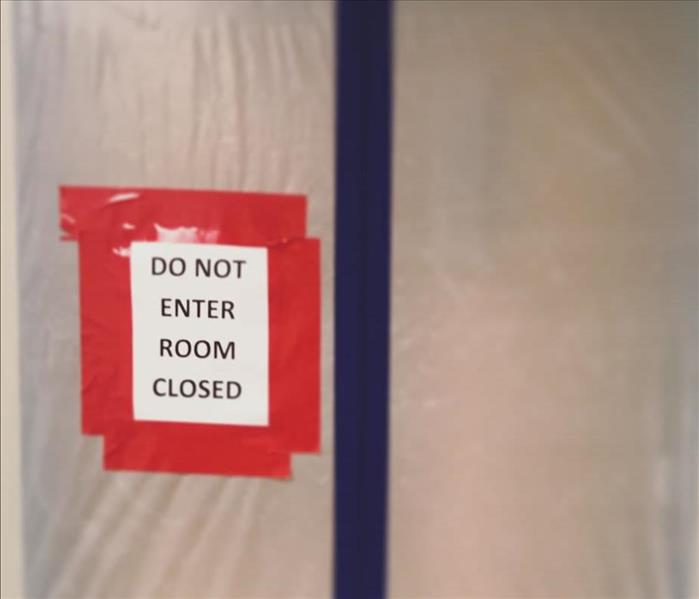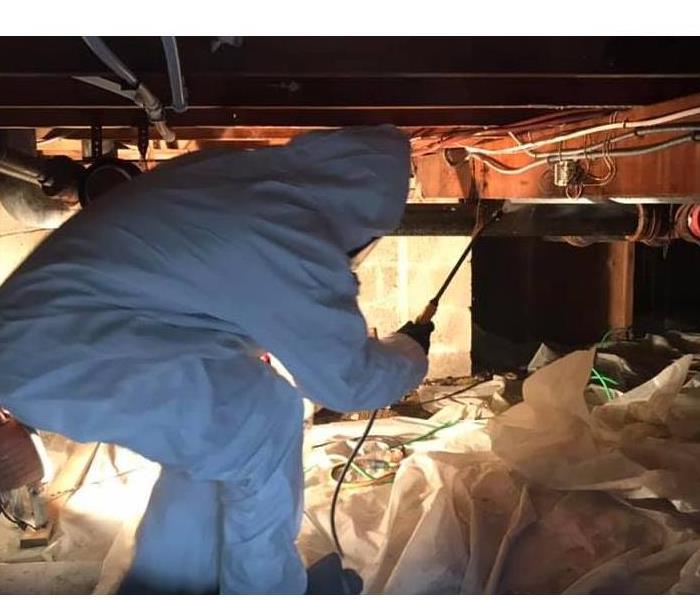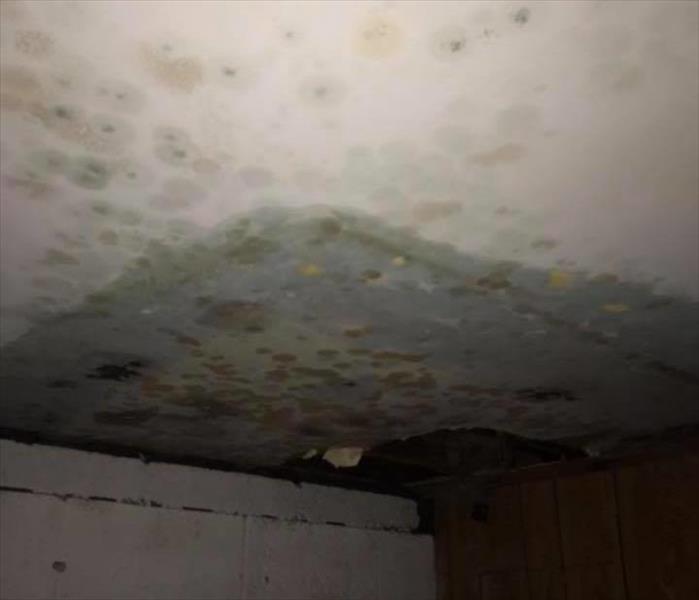Recent Mold Remediation Posts
Kitchen Mold Damage: Quick Tips
8/29/2024 (Permalink)
The kitchen, often considered the heart of the home, is also a prime spot for mold growth due to its constant exposure to moisture. Leaky sinks, damp cabinets, and humid conditions can create the perfect environment for mold to thrive, especially in hidden areas like under sinks, behind appliances, or inside cupboards. Mold in the kitchen not only damages surfaces and structures but can also pose serious health risks, such as respiratory issues and allergic reactions.
Preventing kitchen mold starts with controlling moisture. Regularly inspect plumbing for leaks, ensure proper ventilation, and clean up spills promptly. If you discover mold, it's crucial to address it immediately. Small areas of mold can be cleaned with a mixture of water and detergent, but extensive mold infestations may require professional remediation to ensure complete removal and to prevent future growth. By staying vigilant and addressing moisture issues quickly, you can keep your kitchen mold-free and maintain a healthy living environment for your family.
If you happen to encounter mold in your kitchen, call SERVPRO of Greenwich for help!
Mold Under The Carpet
2/4/2019 (Permalink)
When a homeowner smelled a musty odor in their bedroom, they had the room tested for mold. There was mold found beneath the carpet and subfloor that likely occurred from moisture that was never completely dried. The customer called us to remediate the mold, so we removed the carpet to fix the issue. Once the carpet was pulled back, we removed the visible mold. Next, our crew applied our environmentally-safe mold protection so that the issue would not return. If you suspect or know you have mold, please do not hesitate to call us.
SERVPRO of Greenwich provides 24-hour emergency service and is dedicated to being faster to any-sized disaster. We can respond immediately to your emergency and have the expertise to handle your restoration or cleaning needs.
Mold At A Historical Landmark
2/4/2019 (Permalink)
When we were called to this historical building, we knew that we had to handle this job with extra care. Because of the nature of the building, we needed to eradicate the mold while not damaging the delicate wood. This picture shows mold present on the interior shudders. These shudders along with the rest of the affected area was original dating back to the 1890s. Our expert crew handled the challenge well, removing all visible mold and sealing the wood to prevent subsequent issues. If you suspect or know you have mold, please do not hesitate to call us.
SERVPRO of Greenwich provides 24-hour emergency service and is dedicated to being faster to any-sized disaster. We can respond immediately to your emergency and have the expertise to handle your restoration or cleaning needs.
Mold Containment
1/30/2019 (Permalink)
Mold outbreaks are something to absolutely take seriously. If mold spores become airborne, they can be inhaled. This may lead to unwanted and harmful respiratory issues. But when a mold damage occurs, it usually happens in one part of the home or business. How do we manage this issue while safely and quickly removing mold? When dealing with mold, we build containment areas to be sure no spores are spread. We use disposable plastic to keep the harmful particles out of unaffected areas. This also allows for a minimal disturbance to the daily routine so that business and life can continue.
SERVPRO of Greenwich provides 24-hour emergency service and is dedicated to being faster to any-sized disaster. We can respond immediately to your emergency and have the expertise to handle your restoration or cleaning needs.
Mild Winters Cause Mold
1/28/2019 (Permalink)
We’ve had a pretty mild winter, which means that any water that remains from melting ice or snow will stick around. This leads to mold, which can be harmful to humans and also pets if ingested. This issue will only grow as the weather begins to warm up for the spring season. We can safely and effectively clean mold from surfaces like the exposed wood seen here. We are spraying disinfectant to ensure that after cleaning, mold will not return.
One piece of equipment that we also use is a High-efficiency particulate air (HEPA) purifier. They work by filtering air through a fine mesh, removing harmful particles like mold, dust mites, and pollen that can cause adverse health affects.
SERVPRO of Greenwich provides 24-hour emergency service and is dedicated to being faster to any-sized disaster. We can respond immediately to your emergency and have the expertise to handle your restoration or cleaning needs.
Treat Mold Quickly
6/5/2018 (Permalink)
This is a job that we recently dealt with. The customer had a water damage that was treated by another company. The water was not completely dried out. This led to mold growing in the ceiling when the leftover moisture warmed and provided an ideal habitat for the mold to spread. Unfortunately, because the issue was not properly mitigated by the initial company, SERVPRO needed to demolish part of the ceiling and walls to effectively treat the situation. Now the mold is gone, new ceiling and drywall has been installed, and the customer is back in their home.
If you have a water damage at your home, or you suspect that you have mold growing, do not hesitate to call SERVPRO of Greenwich at (203) 324-1642. Time is of the essence, and they will make it like it never even happened.
Document Recovery with SERVPRO of Greenwich
5/9/2018 (Permalink)
At SERVPRO of Greenwich, we have the ability to save or recover your most important documents after a loss. Whether it be a fire loss, water loss or flooding, or smoke damage, we have the capabilities to clean and dry those documents to have your commercial or residential property back to its original state as soon as possible.
We will begin by taking inventory of your documents at your home or office before we package them to transport for drying.
Once the documents arrive at our facility, they will go through a decontamination process to remove any bacteria left behind, depending on what type of loss has occurred.
We will then go through each box, page by page, to wipe down and remove dirt, soot, or other contaminants. We have 3 levels of cleaning based on the type of soiling, and how heavy it is.
Many times documents that have been affected will hold residual smells of contaminants, or mildew, and should be deodorized before being returned to your client.
With the new age of technology, digitizing records and documents has become a standard practice in most industries. This eliminates the need to have massive file storage rooms and allows us to access records at the click of a button. If your file room was damaged by water, or smoke, and needed to be cleaned, dried, or decontaminated, digitizing might be a good choice to eliminate the need to have 100’s or even 1000’s of documents and records in storage.
During the aftermath of your loss, often times facilities will find that they have documents they no longer need and would simply like to have them disposed of properly. SERVPRO of Greenwich is able to help with this process as well.
Mold In Your Washing Machine
5/8/2018 (Permalink)
We are soon entering warmer weather, which puts us at higher risk for mold and mold-related issues. One place that we often overlook for mold is in our washing machine. Whether top-load or front-load, new or used, every washing machine provides an ideal habitat for mold. The high moisture content in both the machine and the resulting atmosphere, the typical poorly-ventilated laundry room with its stale warm air, and the continual supply of decomposing organic material provided by soiled laundry all contribute to an environment conducive to mold growth and its accompanying mildew smell.
Here is how to ensure your washer and the surrounding area stays free of harmful mold:
You will need the following materials:
• White vinegar
• A natural all-purpose mold killing solution
• A cleaning rag (or sponge)
Begin with the exterior of the machine. Use vinegar or the all-purpose mold killing solution to wipe down the exterior of the machine. This will remove the more visible grime, such as dust and oily fingerprints. (Both organic sources provide floating mold spores with a tantalizing invitation to congregate and colonize.)
Next, clean around the lid and seal. For front-load washers, the rubber door seal will need extra care in order to ensure the removal of mold and mildew. Gently pull back on the rubber stripping and use vinegar or the all-purpose mold killing solution. Even if no mildew or scum is visible, Step 2 is necessary in the prevention of mold growth.
——
Pour two cups of vinegar or lemon juice into the washer. Run the machine for a complete cycle on the longest, hottest setting. This will remove the mold odor and mildew smell, as well as stains and the build-up of detergents.
Once you have completed your cleaning process, discard the rags or sponges that you used, as they may contain harmful mold particles.
The majority of owners neglect to do regular maintenance on their washing machines. In addition, some owners only compound matters by leaving laundry in the machine hours, sometimes even a day or more, after a wash has completed. What is often overlooked is the fact that mold grows quickly and can thrive off of laundry detergent due to its plant-based (and even animal fat or synthetic) components. So use good timing when doing your laundry, and move your clothes to the dryer promptly.
Be Smart About Garage Storage
2/5/2018 (Permalink)
With spring coming in the coming months, most of us try to accomplish new goals, get a new fresh start. Getting healthy, organizing our homes, bettering our lives' always seem to be at the top of the list. One space to start cleaning and organizing is the garage! That extra storage area that easily becomes a catchall for excess items. We have compiled a list of items that should not be stored in your garage. Get them out and reclaim your space.
Paint - Because the garage is prone to extreme temperature changes, paint should not be stored in the garage. Recycle paint or donate it.
Electronics- If you are putting electronics out in the garage, you must not be using them. Donate these items because they can’t withstand the temperature fluctuations and will easily break.
Propane and Hazardous Chemicals- Proper ventilation is key for storage of propane and hazardous chemicals. For safety reasons, these items need to be stored outside.
Food- Keeping food in the garage is an open invitation to rodents and insects. Although shopping in bulk can save money, storing extra food in the garage will cause problems. The moisture and humidity will spoil the food. Find room in the house for food storage.
Cardboard boxes- Insects, mice and other rodents love cardboard. Invest in waterproof plastic bins to store your items.
Mold After A Disaster
2/5/2018 (Permalink)
Picture this: Your home or business is affected by a storm, whether the roof suffered a structural issue, or you had flooding from excess water coming in. You fix the hole in the roof and dry the water yourself, and life continues as normal. A couple months down the road, you find mold where the storm had previously had damaged your building.
Make sure this doesn’t happen.
The Centers for Disease Control (CDC) has some great info about how to prevent mold after a storm hits your home or business.
After natural disasters such as hurricanes, tornadoes, and floods, excess moisture and standing water contribute to the growth of mold in homes and other buildings. When returning to a home that has been flooded, be aware that mold may be present and may be a health risk for your family.
Clean up and dry out the building quickly (within 24 to 48 hours - SERVPRO of Greenwich can help with this). Open doors and windows. Use fans to dry out the building. Position fans to blow air out doors or windows.
Remove all porous items that have been wet for more than 48 hours and that cannot be thoroughly cleaned and dried. These items can remain a source of mold growth and should be removed from the home. Porous, noncleanable items include carpeting and carpet padding, upholstery, wallpaper, drywall, floor and ceiling tiles, insulation material, some clothing, leather, paper, wood, and food. Removal and cleaning are important because even dead mold may cause allergic reactions in some people.
To prevent mold growth, clean wet items and surfaces with detergent and water.
Protect Your Investment by Inspecting Your Crawlspace
2/5/2018 (Permalink)
Over time crawlspaces need maintenance.
Crawl Spaces in Fairfield County
Many homes in southwest Connecticut are built on crawlspaces. Snow load, water runoff, and rising water tables need to be dealt with to maintain your property.
If maintained properly, crawlspaces have advantages over other types of construction.
• It gets the house above the ground, an important point in damp areas.
• It is less expensive than a basement, and comparable to the price of a slab foundation.
• Duct work, plumbing, and electrical can run in the crawl space, which makes them easier to service, and move if necessary.
Items to inspect for are:
• Standing water on top of vapor barrier.
• Condensation or leaks on water pipes or ductwork.
• Muddy soil.
• Staining on walls from water or efflorescence.
• Sagging or missing insulation.
• Plumbing leaks.
• Musty/moldy or foul odors.
• Deteriorated vapor barrier.
If mold is found anywhere in your crawlspace, call SERVPRO of Greenwich to make it "Like it never even happened."
Strange (but common) Places to Find Mold
2/5/2018 (Permalink)
Mold can grow in many places.
When we think of mold problems we equate it to damp basements and black gross mold growing on drywall; but mold is insidious and can grow in places where you least expect it. Mold is fast growing, can pop up within 24 hours of being exposed to moisture, and spreads quickly.
Here are some common places where mold forms that you might not be aware of:
• Under Your Refrigerator
The spaces behind and under your fridge rarely see the light of day, which make them a perfect breeding ground for mold. Clean all water lines and drip pans and ensure they are not leaking; even a small leak can lead to a huge mold problem. Take the extra time to check and clean behind and underneath your refrigerator.
• Chimneys
Your chimney can easily become a breeding ground for mold. Brick crevices collect water, dirt, and other organic debris. Rusted chimney caps and faulty flashing let in rain and snow, encouraging mold to grow. Replace rusted caps and fix flashing. Call a licensed mold removal specialist to remove the mold in your chimneys. To prevent mold, get your chimney cleaned by a professional chimney sweep at least once a year.
• Front-Loading Washing Machines
Front-loading washing machines are great, but can be a hotspot for mold growth. The gasket around the door on front-loading washing machines often stays wet because the door is usually closed when not in use. Add some lint to the moisture and mold happily munches and multiplies. Wipe the gasket and glass dry before you shut the door. If you spot mold, run a hot water wash with some chlorine bleach (no clothes), which will kill the fungi. Even if you have a top-load washer make sure to regularly check behind and underneath your washer and dryer to make sure there are no leaks or source of moisture. Clean out vents and lint traps to prevent mold havens, as well as fire hazards.
• Window Sashes and Seals
Condensation from windows provides the moisture mold loves, and the dirt and dust that collect provide the perfect place for the mold to settle. After heavy rains open windows and wipe moisture from the bottoms of sashes and windowsills. Replace any broken seals and if you notice any water has leaked into the wood and walls call a professional to see if the problem has caused mold.
• Air Conditioners
Air conditioning units trap dust and pollen (a good meal for mold) and grab moisture from the air. If you don’t run your AC unit at least every 24 hours in warm weather humidity in your house climbs, giving mold the opportunity to grow in AC ducts, drain pans, and on coils. Drip pans and drainage hoses on window units can leak causing mold to grow into the windowsill and dry wall. If mold grows in your central air conditioning unit you’ll have to hire a mold remediation pro to clean out the system.
If you suspect you may have mold contact the experts at SERVPRO of Greenwich.
Causes of Mold in Homes
3/9/2017 (Permalink)
Mold is a vital piece of nature, assisting with the disintegration of natural matter and the recycling of supplements in biological systems. While outdoor mold is fundamental, mold developing inside present’s health risks and can bring about property damage. Molds recreate by method of minor airborne spores that travel essentially anyplace, even in our homes.
Despite the fact that there are hints of mold spores indoors, they require the right "ingredients" to produce mold. Unfortunately, the conditions for mold development are found in many homes: a nourishment source, (for example, drywall, rugs, and wood), warmth, lack of light, enough time to develop, and above all, dampness. Since dampness is a fundamental factor in mold development, here are the most common culprits that cause heightened dampness in homes:
- Flooding can cause a measurable amount of water into your home, bringing on serious water damage and conceivably cause mold development inside 24-48 hours. Calling an expert restoration professional such as SERVPRO promptly is your best defense with regards to mitigating water damage and preventing mold development.
- Increased humidity can happen in homes from multiple sources — muggy climate, persistent rain, cooking, showering, and so on. To help prevent development of mold growth in your home, ensure your home is all around ventilated and keep the humidity below 55 percent.
- Deficient ventilation leads to increased humidity, and due to this, mold development and different issues like indoor contamination. Try to open entryways as well as windows when viable and to utilize fans as needed.
- Leaking pipes are a typical issue in homes and should be settled promptly. In many cases, leaks are hidden from view, such as inside walls or above the ceiling, so make a point to investigate wall and ceiling stains routinely.
- Roof leaks are additionally a way for water to saturate your home and cause mold. In the event that you see water stains on the ceiling, check for water damage in the attic and have your roof assessed and repaired at the earliest opportunity.
- Condensation happens when warm dampness loaded air interacts with chilly surfaces. Condensation can be seen on walls, windows, solid floors or metal pipes. Reduce condensation by adjusting the humidity in your home.
- Basements give astounding conditions for mold development because of poor ventilation, cooler temperatures (that advance condensation), and incessant water leaks and flooding.
Mold can also grow in various unexpected areas in the home, which can make mold remediation more difficult. For professional mold removal, as well as fire and water restoration services, contact the professional experts at SERVPRO today.
Intermix Greenwich CT, Sewage and Mold
1/17/2017 (Permalink)
On Dec. 29, an issue regarding a sewage backup was reported on Greenwich Ave., Greenwich CT. The store withholding the location of the problem was experiencing a rancid smell, which they attempted to cover with candles, and complications throughout the whole building when it came to flushing the toilets. Upon the scene were the Fire Marshal, Deputy Chief and Health Department of Greenwich. SERVPRO arrived to offer their services and began to scope out the area of concern in company of the property manager. The building as a whole consisted of three floors and the problem resided within the walls of the basement. The crew on call reached the location by getting through multiple barriers, deep beyond outside vision, when searching for the problematic pipe and when searching came upon yet another complication; mold. Alongside the crew were three air scrubbers, two air dehumidifiers and a bubble of sanitation they created. The SERVPRO of Stamford Crew worked tenaciously to sterilize and dry the entire floor and interior of the walls. After four days of work, the walls are now dry and the problem is on its way to being totally rectified. The demolition is complete and reconstruction is soon to start. SERVPRO of Stamford is always on call to assist you in any stressful situation and our work ethic never ceases until we've acquired your utmost satisfaction.



 24/7 Emergency Service
24/7 Emergency Service
